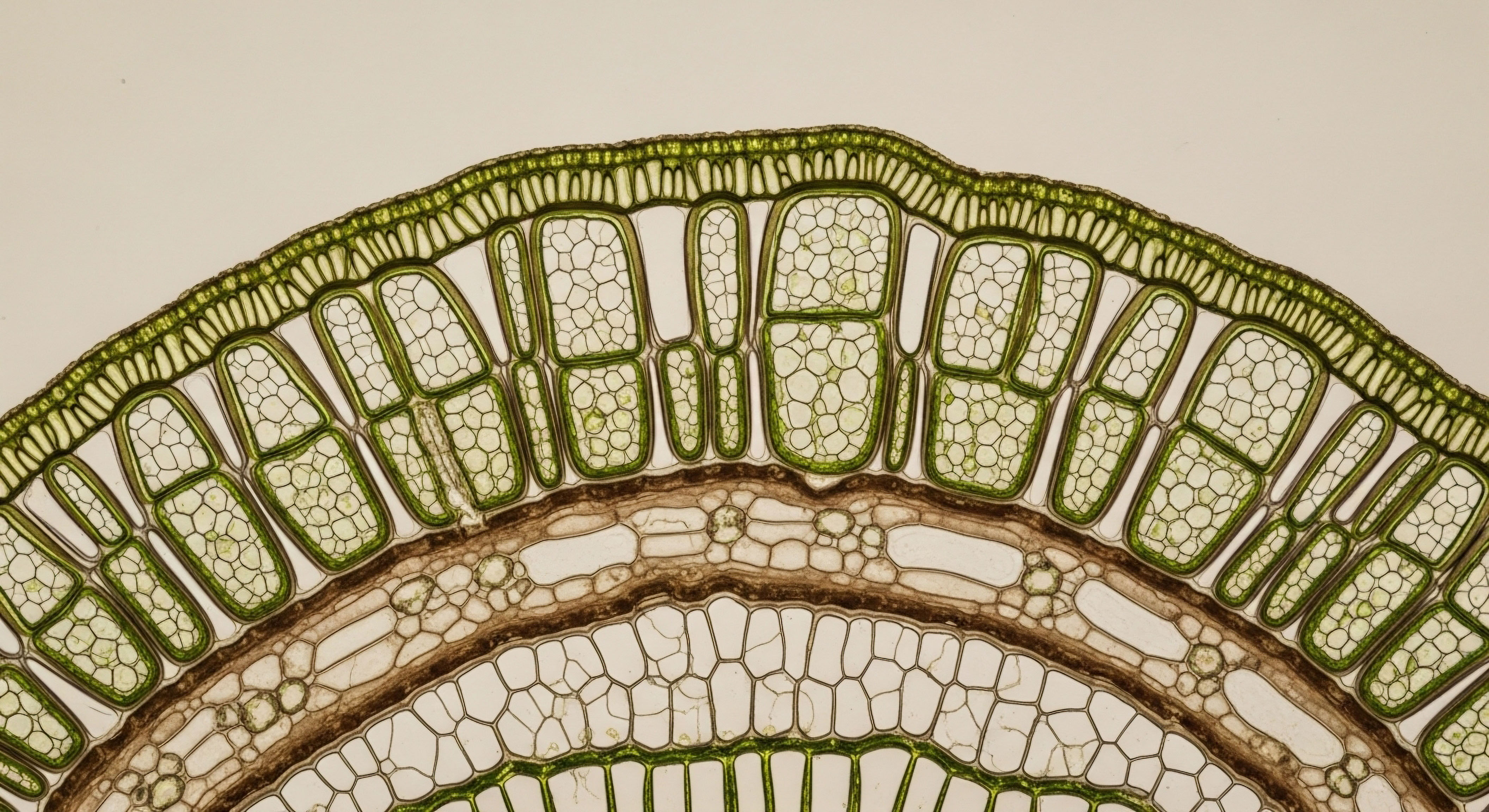

Fundamentals
The decision to begin a testosterone optimization protocol often originates from a deeply personal space. It starts with a felt sense that something is misaligned. Perhaps it is a persistent fatigue that sleep does not resolve, a quietening of ambition, a loss of physical strength, or a decline in the vitality that once defined your sense of self.
When you receive a diagnosis of low testosterone, it provides a name for this experience, offering a tangible biological reason for feelings that can be isolating. The prospect of hormonal optimization presents a clear path toward reclaiming your function and well-being.
Yet, for many men, this path intersects with another fundamental desire ∞ the plan to build a family. This intersection creates a significant and often misunderstood conflict. The very therapy designed to restore masculine vitality can simultaneously compromise the biological capacity for fatherhood.
Understanding this paradox begins with appreciating the body’s intricate internal communication system, the Hypothalamic-Pituitary-Testicular Axis (HPTA). This system functions as a sophisticated, multi-level command structure responsible for male reproductive health. The hypothalamus, located in the brain, acts as the mission commander. It constantly monitors the body’s hormonal environment. When it detects a need for more testosterone, it releases a signaling molecule called Gonadotropin-Releasing Hormone (GnRH). This is the first command in the chain.
GnRH travels a short distance to the pituitary gland, the field officer. Upon receiving the GnRH signal, the pituitary dispatches two of its own messengers into the bloodstream ∞ Luteinizing Hormone (LH) and Follicle-Stimulating Hormone (FSH). These gonadotropins travel throughout the body, but their primary targets are in the testes. LH and FSH carry distinct but coordinated instructions that are both essential for male fertility.

The Testicular Response and the Fertility Shutdown
Within the testes, two types of cells are critical to this process ∞ Leydig cells and Sertoli cells. LH delivers its message directly to the Leydig cells, instructing them to produce testosterone. This endogenously produced testosterone is the primary source of the hormone that circulates in your blood, supporting muscle mass, bone density, libido, and mood.
Concurrently, FSH communicates with the Sertoli cells. Sertoli cells are the direct caregivers for developing sperm, a process known as spermatogenesis. They provide the structural support and nourishment required for germ cells to mature into healthy spermatozoa.
Spermatogenesis is a demanding biological process. It requires two specific conditions to occur successfully. First, it needs the direct stimulatory signal from FSH on the Sertoli cells. Second, it requires an extremely high concentration of testosterone inside the testes, a level that is many times higher than what is found circulating in the bloodstream.
The testosterone produced by the Leydig cells creates this essential local, high-concentration environment. This is the biological synergy at the heart of male fertility ∞ FSH primes the nursery, and a potent local supply of testosterone drives the development.
Herein lies the central challenge of conventional testosterone replacement therapy (TRT). When you introduce testosterone from an external source (exogenous testosterone), your blood levels of the hormone rise. The hypothalamus, in its role as mission commander, senses these high levels. It perceives that the mission is complete and that no more testosterone is needed.
Consequently, it ceases the release of GnRH. This shutdown cascades down the chain of command. Without GnRH, the pituitary stops sending out LH and FSH. Without the LH signal, the Leydig cells halt their own testosterone production, causing the vital intratesticular concentration to plummet.
Without the FSH signal, the Sertoli cells lose their primary activation cue. The result is a testicular environment deprived of its two most important stimuli. Spermatogenesis slows dramatically and, in many cases, stops completely, leading to low sperm counts (oligospermia) or a complete absence of sperm (azoospermia).
Exogenous testosterone administration suppresses the brain’s natural signals to the testes, halting both internal testosterone production and sperm development.
This mechanism explains the apparent paradox ∞ a man on TRT can have optimal testosterone levels in his blood and feel symptomatically excellent, yet be functionally infertile. The therapy effectively bypasses the body’s entire natural production architecture. The communication line between the brain and the testes goes silent. For the man who desires both hormonal optimization and the preservation of his fertility, this presents a significant clinical problem that requires a more sophisticated solution than simple hormone replacement.


Intermediate
Navigating the challenge of maintaining fertility while undergoing male hormonal optimization requires moving beyond conventional replacement models. The goal shifts from merely supplying the body with external testosterone to intelligently modulating the body’s own endocrine system. This involves using specific therapeutic agents that can preserve or stimulate the natural signaling cascade of the HPTA, ensuring the testes remain active and functional.
The primary strategies involve mimicking the body’s own signals or preventing the negative feedback that causes the system to shut down.

Human Chorionic Gonadotropin the Luteinizing Hormone Analog
One of the most established strategies for preserving fertility during TRT is the concurrent use of human chorionic gonadotropin (hCG). hCG is a hormone that is structurally very similar to Luteinizing Hormone (LH). Its primary action in the male body is to bind to and activate the LH receptors on the Leydig cells within the testes.
In essence, hCG acts as a direct substitute for the LH signal that is suppressed by exogenous testosterone. By administering hCG, a clinician can keep the Leydig cells stimulated, thereby maintaining the production of intratesticular testosterone. This high local concentration of testosterone is a cornerstone of spermatogenesis.
The typical protocol involves subcutaneous injections of hCG two to three times per week, at dosages that can range from 250 IU to 1000 IU per injection. The precise dosage is calibrated based on the individual’s response, the dose of testosterone being used, and lab results.
The objective is to provide enough of an LH-like signal to prevent testicular atrophy and maintain sufficient intratesticular testosterone levels without overstimulating the system. While hCG effectively replaces the LH signal, it does not replace the FSH signal. For many men, the maintenance of high intratesticular testosterone is sufficient to preserve sperm production. For others, the lack of direct FSH stimulation may still result in a decline in semen parameters over time.
| Protocol | Systemic Testosterone | LH/FSH Signals | Intratesticular Testosterone | Spermatogenesis |
|---|---|---|---|---|
| TRT Alone | Increased | Suppressed | Severely Decreased | Impaired / Halted |
| TRT with hCG | Increased | Suppressed (hCG mimics LH) | Maintained / Increased | Preserved in most cases |

Selective Estrogen Receptor Modulators a Restoration Approach
An entirely different strategy involves forgoing exogenous testosterone altogether and instead using medications that stimulate the body’s own production. Selective Estrogen Receptor Modulators (SERMs), such as enclomiphene citrate and clomiphene citrate, represent this approach. These oral medications work at the level of the hypothalamus and pituitary gland.
Estrogen, which is produced from the conversion of testosterone, is a powerful negative feedback signal in the male HPTA. SERMs selectively block the estrogen receptors in the pituitary gland. The pituitary, unable to see the estrogen signal, believes that hormone levels are low. In response, it increases its output of both LH and FSH.
This increased gonadotropin output directly stimulates the testes, prompting the Leydig cells to produce more testosterone and the Sertoli cells to support spermatogenesis. This method elevates serum testosterone levels to treat the symptoms of hypogonadism while simultaneously enhancing the natural processes required for fertility. Enclomiphene citrate is often preferred as it is the specific isomer of clomiphene that produces the desired pituitary stimulation with fewer side effects.
- Mechanism of Action ∞ Blocks estrogen feedback at the pituitary, increasing LH and FSH.
- Effect on Testosterone ∞ Increases the body’s endogenous production of testosterone.
- Effect on Fertility ∞ Preserves and often enhances spermatogenesis by boosting both FSH and LH.
- Administration ∞ Taken as a daily or every-other-day oral tablet.
Targeted therapies like hCG and SERMs work by sustaining the body’s own testicular machinery, a critical departure from simple hormone replacement.

What Is the Role of Aromatase Inhibitors?
Aromatase inhibitors (AIs), such as anastrozole, are another class of medication used in male hormonal health. Their primary function is to block the aromatase enzyme, which converts testosterone into estrogen. In the context of TRT, they are often used to manage estrogenic side effects like water retention or gynecomastia.
However, they also have a role in fertility-sparing protocols. By lowering systemic estrogen levels, AIs reduce the negative feedback signal at the pituitary, which can lead to a modest increase in LH and FSH secretion. While not as potent as SERMs for this purpose, they can be a useful adjunct in a comprehensive protocol, helping to optimize the testosterone-to-estrogen ratio and support the HPTA.
Ultimately, the choice of protocol depends on the individual’s specific circumstances, including their baseline hormone levels, the severity of their symptoms, and their timeline for wanting to conceive. A man on TRT who decides he wants to have children may add hCG to his regimen.
A man not yet on therapy who is concerned about fertility from the outset may choose enclomiphene as his primary treatment. These advanced strategies provide a clinical toolkit to resolve the conflict between hormonal health and fertility.


Academic
A sophisticated approach to preserving fertility during androgen optimization protocols is grounded in the detailed molecular biology of the hypothalamic-pituitary-testicular axis and the specific paracrine signaling within the testicular microenvironment. Standard testosterone replacement therapy elevates systemic androgen levels but critically fails to replicate the unique hormonal milieu required for robust spermatogenesis.
The process is dependent on a synergistic dialogue between Sertoli and Leydig cells, a conversation that is silenced by the suppressive effects of exogenous androgens on gonadotropin secretion.

The Paracrine Dialogue FSH and Intratesticular Testosterone
Spermatogenesis is governed by two indispensable gonadotropic inputs to the testis ∞ follicle-stimulating hormone (FSH) and luteinizing hormone (LH). LH stimulates the interstitial Leydig cells to synthesize and secrete testosterone. This locally produced testosterone diffuses into the seminiferous tubules, creating an intratesticular testosterone (ITT) concentration that is approximately 100-fold higher than that found in peripheral circulation.
FSH acts directly on the Sertoli cells, which are the somatic “nurse” cells of spermatogenesis, regulating their proliferative capacity and their expression of genes essential for germ cell survival and maturation.
The process of meiosis, where spermatocytes undergo genetic division, and spermiogenesis, the morphological transformation of spermatids into spermatozoa, are critically dependent on this high ITT concentration acting on the androgen receptors within Sertoli cells. Exogenous testosterone administration suppresses endogenous LH to undetectable levels, leading to a collapse of ITT production by the Leydig cells.
Even with systemic testosterone levels in the therapeutic range, the ITT concentration can fall by over 90%, a level insufficient to support the complete progression of spermatogenesis. Concurrently, the suppression of FSH deprives Sertoli cells of their primary trophic support. This dual deprivation effectively halts the sperm production line.

Reconstituting Gonadal Function Adjunctive Therapies
Clinical strategies to maintain fertility are therefore designed to counteract this gonadotropin suppression. The administration of human chorionic gonadotropin (hCG) serves as an effective LH analog, binding to the LH receptor on Leydig cells and sustaining ITT production. Studies have demonstrated that co-administration of low-dose hCG (e.g. 500 IU every other day) with TRT can maintain ITT levels and preserve semen parameters in a majority of men.
However, hCG monotherapy for fertility preservation during TRT only addresses the LH deficiency. It does not restore FSH levels. While maintaining high ITT is often sufficient, some men may exhibit a decline in sperm quality or quantity over time due to the absence of direct FSH stimulation on Sertoli cells.
In cases of suboptimal response to hCG, or in men with pre-existing spermatogenic defects, the addition of recombinant human FSH (rhFSH) can be considered. This provides a more complete reconstitution of the natural gonadotropic signals, directly supporting Sertoli cell function alongside Leydig cell stimulation.
| Therapeutic Agent | Mechanism | Effect on LH | Effect on FSH | Effect on ITT |
|---|---|---|---|---|
| Exogenous Testosterone | Direct androgen receptor activation; HPTA suppression | ↓↓↓ | ↓↓↓ | ↓↓↓ |
| hCG (adjunct to TRT) | LH receptor agonist | Suppressed (replaced by hCG) | ↓↓↓ | ↑↑↑ |
| Enclomiphene Citrate | Estrogen receptor antagonist at pituitary | ↑↑ | ↑↑ | ↑↑ |
| rhFSH (adjunct) | FSH receptor agonist | (Unaffected) | Replaced by rhFSH | (Unaffected) |

The Superiority of Enclomiphene for HPTA Restoration
A more elegant solution, particularly for men with secondary hypogonadism who are not yet on TRT, is the use of selective estrogen receptor modulators. Clomiphene citrate has been used off-label for years for this purpose. It is a racemic mixture of two isomers ∞ zuclomiphene and enclomiphene.
Enclomiphene is the trans-isomer and functions as a pure estrogen receptor antagonist at the pituitary, leading to the desired increase in LH and FSH. Zuclomiphene, the cis-isomer, has a much longer half-life and exhibits partial estrogen agonist properties, which can be counterproductive and contribute to side effects.
Pure enclomiphene citrate isolates the beneficial antagonistic effects. By blocking estrogenic negative feedback, it robustly increases endogenous production of LH and FSH, leading to elevated serum and intratesticular testosterone while fully preserving the pathways for spermatogenesis. Clinical trials have shown that enclomiphene can raise serum testosterone to levels comparable to topical testosterone gels while maintaining normal sperm concentrations.
In contrast, the testosterone gel groups in the same studies experienced a marked reduction in spermatogenesis. This makes enclomiphene a mechanistically superior option for treating hypogonadism when fertility is a primary consideration.
The academic understanding of fertility preservation hinges on replicating the specific intratesticular hormonal environment, a task that requires nuanced, mechanism-based interventions.
The selection of a specific protocol requires a thorough diagnostic workup, including baseline semen analysis and a clear understanding of the patient’s reproductive goals. For men on established TRT, adding hCG is the standard of care. For treatment-naive men, enclomiphene citrate presents a compelling alternative that addresses both symptomatology and fertility through the restoration, rather than replacement, of the endogenous hormonal axis.

References
- Hsieh, T. C. et al. “Concomitant intramuscular human chorionic gonadotropin preserves spermatogenesis in men undergoing testosterone replacement therapy.” Journal of Urology, vol. 189, no. 2, 2013, pp. 647-50.
- Kim, E. D. et al. “Oral enclomiphene citrate raises testosterone and preserves sperm counts in obese hypogonadal men, unlike topical testosterone ∞ restoration instead of replacement.” BJU International, vol. 117, no. 4, 2016, pp. 677-85.
- Rastrelli, G. et al. “Follicle-Stimulating Hormone (FSH) Action on Spermatogenesis ∞ A Focus on Physiological and Therapeutic Roles.” Journal of Clinical Medicine, vol. 8, no. 7, 2019, p. 1014.
- Kattanam, D. et al. “Enclomiphene citrate for the treatment of secondary male hypogonadism.” Expert Opinion on Investigational Drugs, vol. 24, no. 10, 2015, pp. 1387-94.
- Huijben, M. et al. “Management of Male Fertility in Hypogonadal Patients on Testosterone Replacement Therapy.” Medicina, vol. 58, no. 5, 2022, p. 649.
- Wenker, E. P. et al. “The use of HCG-based combination therapy for recovery of spermatogenesis after testosterone use.” Journal of Sexual Medicine, vol. 12, no. 6, 2015, pp. 1334-40.
- American Urological Association. “Evaluation and Management of Testosterone Deficiency (2018).” AUA Guideline.
- Crosnoe-Shipley, L. E. et al. “Enclomiphene citrate ∞ a treatment that maintains fertility in men with secondary hypogonadism.” Expert Review of Endocrinology & Metabolism, vol. 10, no. 2, 2015, pp. 123-8.
- Ramasamy, R. et al. “Testosterone replacement in the infertile man.” Translational Andrology and Urology, vol. 3, no. 2, 2014, pp. 138-42.
- O’Connor, D. B. et al. “Testosterone Suppression of CRH-Stimulated Cortisol in Men.” Neuropsychopharmacology, vol. 28, no. 8, 2003, pp. 1523-31.

Reflection

Charting Your Personal Health Trajectory
The information presented here provides a map of the biological territory connecting hormonal health and male fertility. It details the intricate systems at play and the clinical strategies developed through decades of scientific inquiry. This knowledge is a powerful tool, shifting the perspective from one of passive symptom management to active, informed participation in your own well-being.
The path forward begins with a clear assessment of your personal health objectives. What does vitality mean to you, not just today, but in the years to come? How do your goals for family planning align with your goals for personal performance and wellness?
A comprehensive baseline evaluation, including detailed hormonal blood panels and a semen analysis, is the essential starting point. These data points provide the coordinates of your current biological position. They are the objective foundation upon which a truly personalized protocol can be built.
This journey is best undertaken as a collaboration with a clinical guide who understands the nuances of these protocols and who respects your individual priorities. The ultimate aim is to create a therapeutic alliance that allows you to achieve a state of optimized function without sacrificing future possibilities. The power to direct this journey lies in the synthesis of this clinical knowledge with your own self-awareness.



